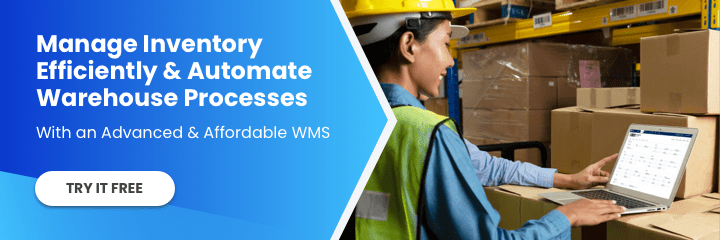[ad_1]
A warehouse management system (WMS) has become a critical aspect in the fast-paced world of modern logistics and supply chain management. It is one component that empowers businesses to streamline their warehouse operations, enhance inventory accuracy, and improve overall efficiency.
In this article, we will delve into the world of warehouse management systems, exploring their definition, key functions, benefits, various types, and answer some of your frequently asked questions.
What is a Warehouse Management System (WMS)
A Warehouse Management System (WMS) is a software solution designed to manage and control the day-to-day operations within a warehouse or distribution center. Its primary objective is to enhance operational efficiency by automating various processes, optimizing inventory management, and facilitating accurate tracking of goods throughout the warehouse.
A WMS ensures the smooth flow of goods and materials within the warehouse from the moment they enter the facility to their eventual shipment. This software also provides real-time visibility into inventory levels, locations, and movements, enabling businesses to make informed decisions and respond swiftly to changing demands.

Core Functions of a Warehouse Management System (WMS)
WMS software is packed with a range of functions that enhance warehouse operations. The key functions of a WMS can be categorized as follows:
1. Inventory Tracking
A WMS enables accurate tracking of inventory items by assigning unique identifiers and locations to each item. This reduces the chances of misplaced or lost items, improving inventory accuracy. It also omits the need to track inventory manually through Excel or paper so that employees can do more productive tasks.
2. Receiving and Put-away
Upon receiving new stock, WMS guides warehouse staff in assigning storage locations based on factors such as item size, weight, and demand patterns.
3. Order Fulfillment
WMS systems enhance order picking and packing processes. They help facilitate the order-picking process by automatically generating picking lists based on orders. They also guide warehouse personnel on the most efficient routes for picking items, ensuring timely and accurate order fulfillment.
4. Space Utilization
WMS solutions assist in organizing warehouse space effectively. They suggest optimal placement of items to maximize space utilization, thereby reducing storage costs.
5. Demand Forecasting
Advanced WMS can create reports with demand forecasting functions, allowing businesses to anticipate inventory requirements and prevent stockouts or overstock situations.
6. Labor Management
WMS software helps allocate tasks to warehouse staff, monitor their performance, and optimize labor resources to achieve higher efficiency and productivity. With a WMS, companies can seamlessly monitor their employees’ output and work hours — keeping them on target.
7. Real-time Visibility
With real-time updates on inventory movements and stock levels, WMS enables better decision-making, reducing the risk of errors and delays in the supply chain.
Read this blog to learn more about must-have advanced functions that WMS software should have.
Benefits of a Warehouse Management System (WMS)
A warehouse management system can yield several benefits for businesses across various industries. Here are some of them:
1. Increased Efficiency
WMS streamlines warehouse processes, reducing manual tasks and errors and optimizing resource utilization, ultimately leading to higher operational efficiency.
2. Improved Order Accuracy
Accurate inventory tracking and guided picking processes result in fewer order inaccuracies and higher customer satisfaction.
3. Reduced Costs
Efficient space utilization, optimized labor management, and lower error rates contribute to cost savings over time.
4. Enhanced Customer Satisfaction
Faster order processing, accurate deliveries, and the ability to provide real-time order tracking contribute to improved customer experience.
5. Scalability
WMS can accommodate increased inventory and order volumes, helping the business scale seamlessly.
6. Data-Driven Insights
WMS generates valuable data on warehouse operations, enabling businesses to make informed decisions for continuous improvement.
Read this blog to learn more about the critical benefits of a warehouse management system.
Types of Warehouse Management Systems (WMS)
Warehouse management systems can be categorized into three main types, each catering to different business needs and complexities:
1. Standalone WMS
This is a basic WMS that focuses solely on warehouse operations. It enables businesses to efficiently manage their processes, such as receiving, putaway, picking, packing, shipping, etc. A standalone WMS can vary from provider to provider; however, it will provide core features such as inventory management.
2. WMS Module in a Supply Chain Management Software
A WMS within a supply chain management software is a module within a bigger system that manages your supply chain operations. The whole system will let you handle all supply chain aspects of creating and delivering a product, such as sourcing, manufacturing, transportation, warehousing, etc.
3. WMS Module in an ERP System
Like the second type of WMS discussed in this article, WMS within an ERP is a module within a bigger system that manages day-to-day business activities. The whole system lets you manage your supply chain, warehousing, accounting, procurement, human resources, etc.
Read this article to learn more about the pros and cons of each type of WMS.

On-Premise vs. Cloud WMS
Some sources consider these as types of WMS, but in reality, they are not comparable to the types of WMS discussed previously. On-premise and cloud WMS are infrastructure options that have corresponding pros and cons. Let’s compare the two.
On-Premise WMS:
- Deployment: With an on-premise WMS, the software is installed and hosted on your company’s own servers and hardware. This provides you with direct control over the infrastructure and data.
- Control: You have full control over the software, including uptime and security. This can be important if your business has specific requirements or regulations that need to be met.
- Customization: On-premise solutions often allow for greater customization to meet unique business needs. You can tailor the system to your exact processes and requirements.
- Data Security: You have direct control over the security measures, firewall settings, and access to data, which might be crucial for businesses dealing with sensitive or regulated data.
- Costs: The upfront costs of purchasing hardware, licenses, and implementation can be higher than cloud-based solutions. Additionally, ongoing maintenance and upgrades are the responsibility of your IT team.
- Scalability: Scaling up an on-premise solution might require purchasing additional hardware and licenses, which can be more time-consuming and expensive than cloud-based options.
Cloud WMS:
- Deployment: Cloud WMS solutions are hosted on remote servers operated by the WMS provider. Users access the system using any browser, eliminating the need for local infrastructure.
- Scalability: Cloud solutions can easily scale up or down based on your business needs. You can adjust the resources and functionalities you need without major hardware changes.
- Costs: Cloud WMS often comes with a subscription-based pricing model, which can reduce upfront costs. You pay for what you use and can adjust your plan as your needs change. However, over the long term, subscription costs can accumulate.
- Maintenance and Updates: The WMS provider is responsible for maintenance, updates, and security patches, freeing your IT team from these tasks.
- Accessibility: Cloud solutions offer greater accessibility since users can access the system from anywhere with an internet connection. This can be beneficial for businesses with multiple locations or remote teams.
- Integration: Cloud-based WMS systems can offer easier integration with other cloud-based applications, enhancing overall business processes and data sharing.
- Time to Implement: Cloud solutions often have shorter implementation times compared to on-premise solutions, which can lead to faster deployment and quicker ROI.
The choice between on-premise and cloud WMS depends on your organization’s specific needs, resources, and priorities. On-premise solutions provide more control and customization but require greater upfront investment and ongoing maintenance. Cloud solutions offer scalability, reduced initial costs, and easier maintenance but might have limitations in customization based on the provider’s offerings.
Is WMS a Type of ERP?
No. Warehouse management systems (WMS) and enterprise resource planning (ERP) systems are designed to improve the efficiency and effectiveness of business operations, but they focus on different aspects of the business.
An ERP system is a comprehensive suite of integrated applications that helps organizations manage various aspects of their business processes, including finance, human resources, procurement, sales, inventory management, customer relationship management (CRM), and more. ERP systems aim to provide a centralized and unified platform for managing all these different functions, allowing for streamlined data flow and better decision-making across the organization.
A WMS, on the other hand, is a specialized application focused specifically on optimizing warehouse operations. It helps manage tasks within the warehouse, such as inventory management, order fulfillment, picking and packing, shipping, and often includes features like barcode scanning, real-time tracking, and optimization algorithms. A WMS ensures that goods move through the warehouse efficiently, reducing operational costs and improving accuracy.
While a WMS is typically a module within an ERP system, it can also be implemented as a standalone solution, especially for businesses with more complex warehouse operations that require specialized software to manage their logistics and inventory processes.
Learn more about the differences between a WMS and ERP through this blog.
Conclusion
As explored in this article, a warehouse management system (WMS) is pivotal in optimizing warehouse processes, managing inventory, and driving overall efficiency. Especially in this fast-paced world of modern business, effective warehouse management is a cornerstone of operational success.
As technology advances, the role of WMS is poised to become even more pivotal in shaping the future of supply chain management. A WMS will be the central orchestrator that will harmonize all the different processes of the warehouse, achieving optimal efficiency and productivity.
If you have additional questions about warehouse management systems, don’t hesitate to reach out to us here. You can also click here to discover an advanced yet affordable WMS solution.
For more information about warehouse management systems or the latest warehouse technologies trends, you can follow us on LinkedIn, YouTube, Twitter, or Facebook. If you have other inquiries or suggestions, feel free to contact us here. We’ll be happy to hear from you.
[ad_2]
Source link
















